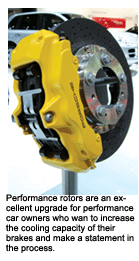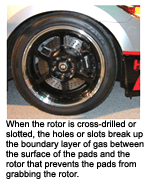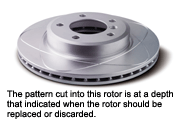You’ve seen them on the race track. You’ve seen them on the street. You’ve seen them in speed shops, in magazine ads, online and probably on eBay, too. The product we’re talking about is slotted and/or cross-drilled high-performance brake rotors. They look great; no doubt about it. Performance rotors are an excellent upgrade for modified sport compact cars, vintage muscle cars, street rods, hard-working fleet vehicles and even super-sized SUVs. Vehicle owners like the look of a cool set of drilled or slotted rotors mounted behind their aftermarket alloy wheels. It’s a “bling” thing with many buyers, but it’s also a worthwhile performance upgrade. It all depends on the application, how the vehicle is driven and whether the customer wants a set of performance rotors for show or for go.
 IT’S ALL ABOUT HEAT
IT’S ALL ABOUT HEAT
The rotors in a disc brake system provide a friction surface for the disc brake pads to rub against when the brakes are applied. Friction created by the pads generates heat and brings the vehicle to a stop.
The underlying scientific principle here is that friction converts the energy of motion into heat — and lots of it. The amount of heat that’s created at the rotors depends on the speed and weight of the vehicle, and how hard the brakes are applied. A normal stop from 60 mph can easily raise the temperature of the front rotors by 150 to 250 degrees. Several hard stops in quick succession can send rotor temperatures soaring into the 600-, 700- or even 800-degree range. A few hot laps around a race track with heavy braking can send brake temperatures even higher (up to 1,000° F or higher), causing the rotors to glow cherry orange or even bright yellow.
If rotor temperatures keep going up because the driver is riding the brakes (as when traveling down a steep mountain) or is driving aggressively, the brakes may get so hot they start to fade. Fade occurs when the brakes are generating more heat than they can dissipate. Once this occurs, it takes more and more pedal effort to slow the vehicle. Eventually, the point may be reached where the brakes can’t generate enough friction no matter how hard the driver stands on the pedal. Under these circumstances, a driver can get into trouble real fast. And if he doesn’t let up on the pedal and give the brakes a chance to cool, he may lose his brakes entirely!
This kind of thing rarely happens on the street with normal driving because stock rotors are designed with ample cooling capacity to handle normal brake temperatures. But when a vehicle has been modified to deliver more performance, is driven aggressively or is forced to operate under punishing driving conditions (like a taxi in stop-and-go city traffic), the stock brakes may no longer be adequate to handle the heat. An upgrade may be needed to improve the cooling capacity of the rotors.
THE BIGGER, THE BETTER
One way to increase the cooling capacity of the brakes is to install larger rotors. The bigger the rotors, the more heat they can handle. A large, heavy vehicle, like a Toyota Sequoia or Land Cruiser, obviously creates more heat when braking than a little vehicle, like a Ford Focus or a Honda Civic, because of its heavier mass. That’s why the rotors on most SUVs are several inches larger in diameter than those on a passenger car. But on a performance car like a Porsche, the stock rotors may be as large as those on a SUV.
On the race track, higher-than-normal speeds increase the heat the brakes must handle regardless of the vehicle’s size or mass. That’s why most race cars have huge rotors — so they can stop quickly without frying the brakes.
Unfortunately, it isn’t easy to change the size of the rotors on many vehicles. Bigger rotors mean repositioning the calipers and/or going with large calipers, too. There are aftermarket conversion kits for some vehicles, but not for all.
 KEEPING THEIR COOL
KEEPING THEIR COOL
“Vented” rotors have ribbed cooling fins between the rotor faces to help pull air through the rotor for better cooling. Vented rotors are typically used on the front brakes of most vehicles because the front brakes work much harder than the rear brakes. Some rotors are “solid” or “unvented” and have no internal cooling fins. They are used mostly for light-duty applications or the rear brakes on cars with four-wheel disc brakes.
Rotor cooling is also affected by the design of the cooling ribs between the rotor surfaces. Vehicle manufacturers currently use more than 70 different cooling rib configurations in their rotors. Some ribs are straight, some are curved, some are segmented, and some are evenly spaced while others are not. Most ribs radiate outward from the center, but others zigzag like a maze. Different cooling rib configurations are used to “optimize” brake cooling on specific vehicle applications and to reduce harmonics that contribute to brake squeal.
To maximize cooling, you want as much air flow through the rotor as possible. The cooling fins act like fan blades and help pump air through the rotor. Directional rotors typically cool better than nondirectional rotors.
Increasing the number of fins and how they are oriented can improve cooling by 10 to 15 percent or more. A stock rotor might have 36 cooling ribs between the faces of the rotor, while an “economy” replacement rotor might have only 32. A performance rotor on a race car, on the other hand, might have as many as 48 cooling fins and pump more hot air than a politician who’s running for re-election.
Many race cars also use external cooling ducts to route even more air to the rotors, and some even have fans to increase air flow to the brakes. The more air that gets to the brakes, the cooler they run and the better able the car is to brake repeatedly without the brakes fading.
SLOTTED ROTORS
Most serious racers today have gotten away from cross-drilled rotors and now run slotted rotors or ones that use both slots and holes. Slotted rotors typically have four to eight evenly spaced shallow grooves milled into both surfaces of the rotor. The slots provide the same pad-venting benefits as holes, but with less risk of cracking because the slots usually don’t extend all the way through the rotor (though some do). The slots are usually angled and curved so they sweep under the entire surface of the pads, providing much better venting than a series of holes.
Some slot designs can act as a visual indicator to the condition of the rotor. One rotor manufacturer machines a slot into the discard or minimum wear depth. This can be a visual indicator to technicians and consumers that the rotor needs to be replaced. Other manufacturers are using dimples that are set at different depths to indicate the state of the rotor.
Slots also have a “shaving” effect that maintains a cleaner pad surface for better pad-to-rotor contact. It’s like constantly dressing a grinding wheel to keep it smooth and flat.
DRILLED ROTORS
Years ago, racers started cross-drilling rotors with small holes to increase cooling. Drilling 30 to 40 evenly spaced holes through the rotors increased air flow and cooling for faster heat dissipation — at least in theory. The actual results were not that dramatic, and some said it didn’t reduce rotor temperature much at all. But the holes did provide an unexpected benefit. They provided vents or gas ports through which hot gasses given off by the brake pads could escape.
The phenolic resins that are used as binders to hold brake pads together give off vapors when they get extremely hot. The gas can form a boundary layer between the pads and rotor that reduces friction. The effect is similar to that of a plastic puck on an air hockey table. Air holds the puck aloft and allows it to easily glide across the surface. In the case of a hot set of brake pads, a boundary layer of gas between the surface of the pads and the rotor that prevents the pads from grabbing the rotor, reduces friction and stopping power when you need it most.
If the rotor is cross-drilled or slotted, the holes or slots break up the boundary layer and provide a path for the gas to escape. Now the pads can make full contact with the rotors for maximum braking effectiveness, even when they are sizzling hot.
What’s more, holes and slots also help clear away dust and debris that may become trapped between the pads and rotor. At a microscopic level, debris between the pads and rotor can reduce the physical contact area of the pads against the rotors. This also reduces friction and braking effectiveness. So by whisking away the debris, the pads are able to maintain maximum surface contact with the rotors when the brakes are applied.
 NO CRACKS, PLEASE
NO CRACKS, PLEASE
Cross-drilling rotors may seem like a great idea but, if done improperly, it can have serious consequences. Drilling a hole through the surface of a rotor creates a stress point in the metal. If the edges of the hole are not radius chamfered to dissipate these stress points, the hole may concentrate stress to the point where cracks start to form and propagate outward from the hole. Cracks are something you don’t want in a brake rotor because they can lead to catastrophic rotor failure!
We’ve seen rotors that have literally exploded like a hand grenade because somebody drilled them full of holes. Too many holes can weaken a rotor, even if the edges on all the holes are carefully chamfered. The rotor doesn’t have to look like Swiss cheese to provide adequate gas venting. Thirty to 40 well-placed 1/8-inch holes will usually do the trick.
The placement of the holes is also critical. The holes need to sweep under the pads in such a way that the gas is vented quickly and efficiently. The holes must not be too close to the inside or outside edges of the rotor because this also increases the risk of cracking.
Some performance rotor manufacturers don’t drill the holes all the way through the rotor surface, and instead use a “blind-hole” approach that reduces the risk of cracking. The depth of the hole is still enough to provide some momentary venting when the holes pass under the pads.
If a customer wants cross-drilled rotors, we don’t advise drilling the rotors yourself. It’s too risky and there is too much liability involved. The best advice is to install pre-drilled aftermarket performance rotors from a reputable supplier that knows what they’re doing and has a reputation for quality.
METALLURGY IS IMPORTANT
Another factor that affects rotor performance is the metallurgy of the rotor itself. The metallurgical properties of the iron determine the rotor’s strength, noise, wear and braking characteristics. The casting process must be carefully controlled to produce a high-quality rotor. The rate at which the iron cools in the mold is critical and must be closely monitored to achieve the correct tensile strength, hardness and microstructure.
When iron cools, carbon atoms that are mixed in with the iron form small flakes of graphite that help dampen and quiet noise. If the iron cools too quickly, the particles of graphite don’t have as much time to form and are much smaller in size. The result is a noisy rotor.
The rate of cooling also affects the hardness of the rotor. If a rotor is too hard, it will increase pad wear and noise. Hard rotors are also more likely to crack from thermal stress. If a rotor is too soft, it will wear too quickly and may wear unevenly, increasing the risk of runout and pedal pulsation problems.
The composition of the iron must also be closely controlled during the casting process to keep out impurities that may form “inclusions” and hard spots.
Some performance rotors are made of alloys such as 4130 chrome moly steel, and may be coated with titanium or ceramic on the wear surfaces. Such rotors provide high tensile and yield strength, and are typically used in race cars. The same kind of rotors can also be used on the street, but are probably overkill for the average Joe who may only be a weekend racer.
THE FINISH ALSO COUNTS
The surface finish on the rotors is also extremely important because it affects the friction characteristics of the brakes, pad seating, break-in, wear and noise. As a rule, most new OEM rotors today have a surface finish between 30 and 60 inches RA (roughness average), with many falling in the 40 to 50 RA range. Some OEM specifications say that anything less than 80 RA is acceptable — but smoother is always better.
Aftermarket performance rotors come pre-finished and should require no additional machining prior to installation. So don’t turn the rotors to “clean them up” because they’re ready to go out of the box.
Most aftermarket street performance rotors are compatible with virtually any friction material. But the best results are usually obtained with semi-metallic or ceramic pads. Semi-metallic pads conduct heat well and are designed to work best at high temperatures.












